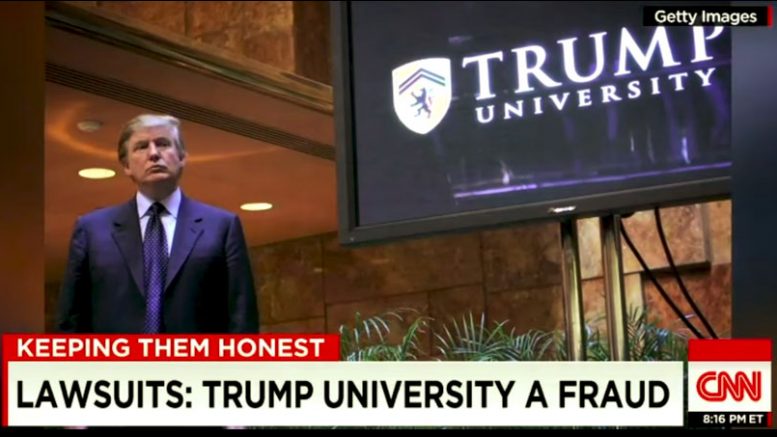Last week, president-elect Donald Trump settled the pending Trump University case to the tune of $25 million.
The lawsuit has attracted a great deal of attention in recent months. It had been scheduled for November 28 before Judge Jeffrey Miller mediated an outcome that appears to have been mutually satisfactory for all parties.
While it should be noted that this settlement did not include an admission of guilt or liability — and Mr. Trump’s staffers insisted that they settled to allow them to focus on preparing for the presidency — it’s still important to examine what was at stake.
First, some background: Trump University operated from 2005 to 2010, though it was later renamed the Trump Entrepreneur Initiative in response to a complaint from the New York State Department of Education.
Officials noted that the organization lacked a charter, accreditation and licensing, making the “university” in the title potentially deceptive. Trump University offered real estate training, and like other Trump endeavors, it relied heavily on the real estate magnate’s name as an advertising point. That turned out to be one of the sticking points that landed the organization in legal hot water.
At issue were three separate lawsuits.
One, Low v. Trump University, LLC, was a class action lawsuit filed in 2010 against the organization, not Donald Trump himself — unlike Cohen v. Trump , which was filed in 2013. Also in 2013, the State of New York sued Trump University for fraud, calling the organization a ” swindle .”
Litigation swirling around a presidential candidate is bound to attract attention, especially in light of his comments indicating a refusal to settle , and his attacks on the US District Judge Gonzalo P. Curiel on the basis of his heritage .
While the case was scheduled for after the election to avoid any interference, Mr. Trump’s attorneys attempted to push it back to after the inauguration. Curiel denied the request, though he did encourage the parties to negotiate a settlement.
Two critical points were in question: the legality of the “university” and the promises made in marketing material.
The State of New York insisted that the organization had violated the law by labeling itself a university despite lacking the qualification to do so — and after warnings to stop advertising itself as such.
The other suits revolved around Mr. Trump’s level of involvement in the organization. Plaintiffs claimed that marketing materials suggested he was closely involved in the selection of staff and took a personal interest in the activities of the organization when this wasn’t the case. Former staffers maintained that the program resembled a bait and switch designed to entice participants to spend more money at each step of their involvement.
Some 7,000 former participants will receive payouts under the settlement, in some cases amounting to a full refund of what they spent on courses. The State of New York will receive one million dollars, and appears to be pleased with the outcome of the suit.
With the suits resolved, the matter is closed in the court of law, though the court of public opinion may have other ideas.
Trump U was a hammering point for Republicans and Democrats alike during the primaries, and it remains a popular subject of discussion. Mr. Trump’s business dealings are under particularly close scrutiny right now due to concerns about potential conflicts of interest when he arrives in the White House.
This resolution of some serious legal questions may prove to indicate how he and his team intend to move forward in addressing concerns about the linkage between the White House and the Trump Organization.
The bottom line in this case is that Donald Trump was accused of fraudulent activities in business dealings dating back to the early 2000s, in a civil court — which has a lower burden of proof than a criminal court. And he opted to settle after becoming president-elect, without admitting responsibility, rather than continue with litigation that had already been protracted over the course of many years. Trump did so after urging from the judge on the case — and possibly under advice from his attorneys, as well.
Whether Trump opts to take legal advice on the potential conflicts of interest between his business and his office remains to be seen. This piece was reprinted by Truthout with permission or license. It may not be reproduced in any form without permission or license from the source.
Last week, president-elect Donald Trump settled the pending Trump University case to the tune of $25 million.
The lawsuit has attracted a great deal of attention in recent months. It had been scheduled for November 28 before Judge Jeffrey Miller mediated an outcome that appears to have been mutually satisfactory for all parties.
While it should be noted that this settlement did not include an admission of guilt or liability — and Mr. Trump’s staffers insisted that they settled to allow them to focus on preparing for the presidency — it’s still important to examine what was at stake.
First, some background: Trump University operated from 2005 to 2010, though it was later renamed the Trump Entrepreneur Initiative in response to a complaint from the New York State Department of Education.
Officials noted that the organization lacked a charter, accreditation and licensing, making the “university” in the title potentially deceptive. Trump University offered real estate training, and like other Trump endeavors, it relied heavily on the real estate magnate’s name as an advertising point. That turned out to be one of the sticking points that landed the organization in legal hot water.
Source: www.truth-out.org




